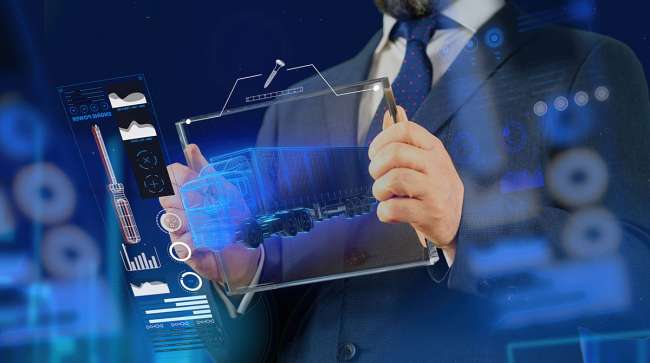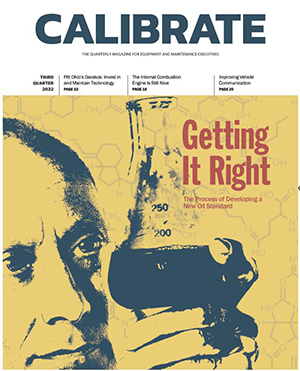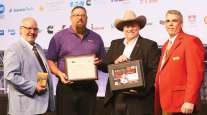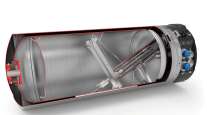Data Interchange/Interoperability Challenges Carriers to Take Action

[Find the latest in equipment & maintenance: Explore this quarter's issue of Calibrate]
In his commentary on the technological and societal challenges facing the world in 1905, George Santayana stated in The Life of Reason, “Those who cannot remember the past are condemned to repeat it.” Although Winston Churchill’s spin on the quotation in 1948 has gained more notoriety, the essence of this thought is as applicable today as ever, and especially in the expanding universe of trucking industry information technology.
A significant technology challenge faced the industry a quarter century ago as computer technology was employed to attain groundbreaking emissions performance in commercial motor vehicles. The introduction of Engine Control Units (ECUs) into decades-old diesel power plants was the enabler, based in Windows technology, which gradually opened a new world of development of software applications for fleet maintenance, ECU reprogramming, and vehicle diagnostics and beyond.
The commercial vehicle had become a data hub, communicating across the onboard CAN/J1939 physical datalink, including telematics generated by the trailer. Developers of diagnostic devices and applications to link vehicle data with maintenance quickly produced proprietary approaches to Vehicle Diagnostic Adapters (VDAs), resulting in a patchwork of frequently incompatible systems that required work-around patches to allow fleets to operate across platforms, which fleets as well as the telematics service providers who act as data integrators and analytics, quickly realized as untenable.

Legler
In response, fleets leveraged American Trucking Associations’ Technology & Maintenance Council (TMC) to bring OEMs and suppliers to the table through the Council’s S.12 Onboard Vehicle Electronics Study Group. By 1997, TMC published Recommended Practice (RP) 1210, which specifies a standardized application program interface (API) between personal computers and onboard vehicle communications under the Microsoft Windows family of operating systems. Any developer can employ RP 1210 in implementing software systems for ECU communications or VDA devices, and with strong commitment from the industry’s leading fleets, this became commonplace. The four subsequent revisions of RP 1210 have kept up to date with not only Windows operating system evolution, but also added provisions for cross-platform integration of Non-Windows systems such as Linux and Unix as well iOS and Android mobile operating systems.
More Q3 Calibrate
►Getting It Right: Developing New Oil Standards
►Cameras on Windshield Remain FMCSA-Compliant
►Five Questions: Taki Darakos, Pitt Ohio
►Freeze: Trust the Innovation Process
►Baxter: Internal Combustion Engine's Demise May Be Greatly Exaggerated
Explore the Issue!
Fleets were the primary clients for the datasets produced by onboard systems, and utilization of standardized messaging protocols enabled the development of a growing array of sensors and the tractor-trailer architecture to include monitoring of cargo identification, security and cargo conditions, thus making the truck data hub an integral part of global logistics systems and networks meaning that every CMV of the future will be a microcosm of the cyber universe.
In today’s environment and into the future additional data “customers” are entering the fray. Technology has enabled the development and deployment of technologies that can communicate with the Internet of Things (IoT) in the developing intelligent highway system. Prototype automated driving systems (ADS) have used their artificial intelligence (AI) via machine learning to advance system capabilities on the fly in real time to move closer to “singularity” — the point at which the machine can think and react as well as a sentient human operator. Parallel to this, of course, is an evolution in the cyber-planning processes of the regulatory community that is charged with assuring the public that commercial transportation operations and its attendant technology is safe and trustworthy enough to operate interactively with the general highway public.
Fleets will need to prove to environmental regulators that the vehicle’s environmental impact is in conformance with national and state standards as well as its maintenance state and if fault codes have been corrected in a timely manner. Environmental accountability protocols will likely soon require companies managing transportation of the global supply chain to account for emissions down to the fleet level for calculation of carbon footprint.
All of the above contributes to a legitimate need for, and a demand for, real-time data from the commercial vehicles of today and tomorrow, and the ability to pose queries and communications regarding vehicle and systems operation status, cargo security and condition, and environmental and safety performance.
Fleets will need to monitor telematics both to proactively correct impending component failures before they turn into an out-of-service condition far from the maintenance facility that may be able to correct the problem. With the reality of a driverless vehicle interacting with the instructions of law enforcement in emergency situations looming on the horizon, the control of data, and the protection of the vehicle and its onboard technology against a hostile global threat environment, as has been the case with back-office systems, will be a daily reality of fleet maintenance operations in only a few very short years. And the vehicle itself will be a “customer” for data from the intelligent highway network, will need to take advantage of the embedded technology and data from Health Ready Components (HRC) into Intelligent Vehicle Maintenance Systems (IVHS) and will need to communicate interactively with Electric Vehicle Charging Equipment (EVCE) via a handshake between the power control module and the charging station.
TMC’s study groups are evolving current and future RPs to enable mega-data interchange and interoperability in the contact of fleet maintenance and ensuring operational utility and reliability. As truck-tractor and trailer OEMs are predicting expansion of onboard data management into as many as a dozen and even more sub-networks, there’s an urgency for a fleet-driven approach to new IT specification and maintenance guidelines along a process similar to what led to RP 1210, as the council’s lead members have realized that the same trend toward “proprietary incompatibility.”
Vince Vanszl, onboard systems manager for Penske Truck Leasing, who currently chairs TMC’s S.12 Study Group, noted:

3PL problem-solvers discuss the supply chain and how they use technology to improve their customer competitiveness. Tune in above or by going to RoadSigns.TTNews.com.
“In today’s ever-changing IoT and telematics industries the need for standardization becomes more apparent by the day. Mergers, acquisitions and business closings in addition to new technology while innovative and helpful threaten to disrupt a fleet’s dataflow and create costly changes and even data loss. TMC’s S.12 study group is working to introduce RPs to address these issues through standardization. Standardization will allow fleets easier access to vehicle data and make changing providers or adding new technology less costly.”
Vanszl continues, regarding two task forces that working on RPs to address this situation: S.12’s RP 1226 Messaging Standardization and Open Telematics API (OTAPI). He stated:
“The RP1226 Messaging Standardization Task Force’s objective is to create a ‘level playing field’ for all parties and allow fleets access to the data that they need while ensuring competition at all supplier levels without having to splice into the truck/trailer and get the data yourself. OTAPI is intended to make the telematics system provider (TSP)-carrier interface the same across multiple TSPs. If a TSP is part of a merger or acquisition or suddenly goes out of business, as has happened in the industry recently, any commercial fleet relying on its service will need to find a new provider. Due to the lack of a standardized data format and methods for retrieving telematics logs and data, a commercial fleet manager will have to reintegrate an alternate telematics provider’s data format into their existing system reporting. OTAPI addresses this issue by providing a standard that all TSPs can follow. We really need fleets to participate and understand how standardization will keep their dataflows working smoothly and seamlessly, when we are able to get that point across I have no doubt that fleet participation in TMC will soon in be at an all-time high.”
Wally Stegall, technical fellow and director of The Morey Corp., is 2nd vice chairman of TMC’s Future Truck Committee (FT). He also chairs TMC’s Future Truck Intelligent Vehicle Management System Task Force and the Health Ready Component Standards Task Force under the S.5 Fleet Maintenance Management Study Group. Stegall addressed these issues at TMC’s Fleet Data Management and Cybersecurity Conference, held June 13 at ATA’s new headquarters in Washington, D.C.
He reinforces Vanszl by saying, “A Telematics API is fundamental to interoperability in a world where the vehicle as an asset is a server with multiple clients. In today’s world the IoT enablers or services at the asset need to be the right option for the mission. The Telematics API will allow the fleet to interface with those enablers and services. Additionally, as actionable data becomes critical to real-time maintenance management, the telematics API will enhance the ability of the fleets to access data. All ATA/TMC recommended practices and products such as RP1210, RP1226, cyber practices, evolving IVHM, and adoption of TMC’s Vehicle Maintenance Reporting Standards (VMRS) codes as a corrective action mechanism will be critical to a new interoperable IoT environment for asset management and maintenance.
To make the APIs being maintained by ATA/TMC more relevant in fleet enterprise, fleet maintenance and fleet presentation of information to regulatory bodies requires the ability to document the digital footprint of an asset in a machine-readable structure based on VMRS from design of asset to decommissioning of asset many years later.”
“When it comes to this issue, the potential for proprietary solutions being forced on fleets is very great with questionable benefit to the fleet itself, said TMC Executive Director Robert Braswell. “This is comparable in need to when two decades ago fleets pushed for and TMC responded with RP 1210 to tame the divergence of proprietary diagnostics adapters.”
Want more news? Listen to today's daily briefing above or go here for more info
In learning from our own history, technological innovations are best incorporated into the industry when fleets control and clearly articulate their needs, manufacturers and suppliers actively research these needs and consensus is cooperatively attained through a disciplined process to facilitate open and non-restrictive norms and practices. Fleets, therefore, are called to commit to the same technical leadership as has always been the case with traditional physical commercial vehicles. TMC provides the only fleet-centric forum for the development of these essential practices for safe, efficient and environmentally protective utilization of transportation assets into the future. Fleet IT experts are called upon to take up the mantle of thought leadership in the emerging world of intelligent maintenance and data-drive interaction with regulators and our global customers.
TMC’s 2022 Fall Meeting, which will take place at the Huntington Convention Center in Cleveland Sept. 25-29, along with this year’s National Technician Skills Competition, is the perfect opportunity to learn more about how data interchange is driving and intertwining with fleet maintenance management. All TMC Task Forces, including those mentioned above, will meet Sept. 27.
For more information on how to become involved, see tmcfall.trucking.org. For questions on how to become involved in TMC’s Recommended Practices, contact Jack Legler, TMC Technical Director, email: jlegler@trucking.org.





